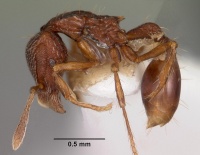Strumigenys euryale
| Strumigenys euryale | |
|---|---|

| |
| Scientific classification | |
| Kingdom: | Animalia |
| Phylum: | Arthropoda |
| Class: | Insecta |
| Order: | Hymenoptera |
| Family: | Formicidae |
| Subfamily: | Myrmicinae |
| Tribe: | Attini |
| Genus: | Strumigenys |
| Species: | S. euryale |
| Binomial name | |
| Strumigenys euryale (Bolton, 2000) | |
Nothing is known about the biology of Strumigenys euryale.
Identification
Bolton (2000) - A member of the Strumigenys leptothrix-group. Strumigenys euryale is immediately identified by its unique clypeal crest. Its propodeum, with sharp spines subtended by a carina rather than a lamella, also occurs in Strumigenys rudinodis (see there) and its allies. In these species, however, the propodeal lobes are acutely triangular, whereas in euryale the propodeal lobes are low and broadly rounded. A similar propodeal structure is seen only in Strumigenys stheno, but this is a densely hairy species with a shallowly convex clypeus and a row of straight simple long hairs project forward at right-angles to the leading edge of the scape.
Keys including this Species
Distribution
Latitudinal Distribution Pattern
Latitudinal Range: 6.733167° to 6.733167°.
| North Temperate |
North Subtropical |
Tropical | South Subtropical |
South Temperate |
- Source: AntMaps
Distribution based on Regional Taxon Lists
Indo-Australian Region: Borneo, Indonesia, Malaysia (type locality), Philippines.
Distribution based on AntMaps
Distribution based on AntWeb specimens
Check data from AntWeb
Countries Occupied
| Number of countries occupied by this species based on AntWiki Regional Taxon Lists. In general, fewer countries occupied indicates a narrower range, while more countries indicates a more widespread species. |

|
Estimated Abundance
| Relative abundance based on number of AntMaps records per species (this species within the purple bar). Fewer records (to the left) indicates a less abundant/encountered species while more records (to the right) indicates more abundant/encountered species. |

|
Biology
Castes
Nomenclature
The following information is derived from Barry Bolton's Online Catalogue of the Ants of the World.
- euryale. Pyramica euryale Bolton, 2000: 432, fig. 272 (w.) BORNEO. Combination in Strumigenys: Baroni Urbani & De Andrade, 2007: 119
Unless otherwise noted the text for the remainder of this section is reported from the publication that includes the original description.
Description
Worker
Holotype. TL 2.8, HL 0.76, HW 0.50, CI 66, ML 0.05, MI 7, SL 0.36, SI 72, PW 0.30, AL 0.78. Anterior half of clypeal dorsum with its centre raised into a high median longitudinal crest that is densely clothed with spatulate hairs. In full-face view the upper scrobe margin with a row of anteriorly curved appressed small spatulate hairs; without freely projecting long hairs of any form. Dorsolateral margin of occipital lobe, behind the level of the scrobe, with 2 freely projecting long simple hairs that curve anteriorly. Cephalic dorsum behind clypeus finely rugulose to reticulate-rugulose; spaces between rugular sculpture on vertex with weak punctulate ground-sculpture. Leading edge of scape with apically-directed minute appressed hairs only. Eye with 4 ommatidia in longest row. Dentition discussed in introduction to group. With head i n profile the dorsum without standing hairs except for a single transverse row close to the occipital margin. Pronotum sharply marginate dorsolaterally, with a long simple humeral hair and 1-2 others arising from the margin; dorsum between the marginations more or less flat, with scattered longitudinal rugulae and without elongate standing hairs. Dorsum of mesonotum with 3 pairs of simple standing hairs, the posteriormost pair almost at the metanotal groove. Dorsal (outer) surfaces of middle and hind tibiae with freely projecting simple hairs, the longest of them about equal to the maximum tibial width or only very slightly more. Similar hairs also arise from the femora. Propodeum armed with a pair of short acute spines that are subtended by narrow carinae; these terminate at the base of the declivity in a pair of low rounded propodeal lobes that are not laminate nor spongiform. Side of alitrunk mostly unsculptured but irregular, and with a few transverse rugulae on the mesopleuron. Lateral spongiform lobe of petiole restricted to posterolateral portion of node, distinctly not extending to level of anterior face of node.
Paratypes. TL 2.8-3.0, HL 0.76-0.81, HW 0.48-0.52, CI 63-67, ML 0.04-0.06, MI 5-8, SL 0.34-0.37, SI 71-79, PW 0.30-0.34, AL 0.78-0.86 (7 measured). As holotype but eye with 4-5 ommatidia in the longest row. Dorsolateral margin of occipital lobe with 1-3 laterally projecting elongate curved simple hairs.
Type Material
Holotype worker, Malaysia: Sabah, Crocker Range, 1600 m., 18.v.1987, no. 30a (Lobl & Burckhardt) (Musee d'Histoire Naturelle Genève). Paratypes. 13 workers with same data as holotype; 2 workers with same data but Crocker Range, K.K. - Tambunan, no. 30; 1 worker, Sabah, Mt Kinabalu, Liwagu Trail, 1500 m., 21.v.1987, no. 34a (Lobl & Burckhardt) (MHN, The Natural History Museum, Museum of Comparative Zoology, Australian National Insect Collection).
- Paratype, 1 worker, Crocker Range, Sabah, Malaysia, Löbl,I. & Burckhart, ANIC32-001164, Australian National Insect Collection.
References
- Baroni Urbani, C. & De Andrade, M.L. 2007. The ant tribe Dacetini: limits and constituent genera, with descriptions of new species. Annali del Museo Civico di Storia Naturale “G. Doria” 99:1-191.
- Bolton, B. 2000. The ant tribe Dacetini. Memoirs of the American Entomological Institute. 65:1-1028. (page 432, fig. 272 worker described)
- General, D.E.M., Buenavente, P.A.C., Rodriguez, L.J.V. 2020. A preliminary survey of nocturnal ants, with novel modifications for collecting nocturnal arboreal ants. Halteres 11: 1-12 (doi:10.5281/ZENODO.3707151).
- Tang, K. L., Guénard, B. 2023. Further additions to the knowledge of Strumigenys (Formicidae: Myrmicinae) within South East Asia, with the descriptions of 20 new species. European Journal of Taxonomy 907, 1–144 (doi:10.5852/ejt.2023.907.2327).
References based on Global Ant Biodiversity Informatics
- CSIRO Collection
- Pfeiffer M.; Mezger, D.; Hosoishi, S.; Bakhtiar, E. Y.; Kohout, R. J. 2011. The Formicidae of Borneo (Insecta: Hymenoptera): a preliminary species list. Asian Myrmecology 4:9-58

